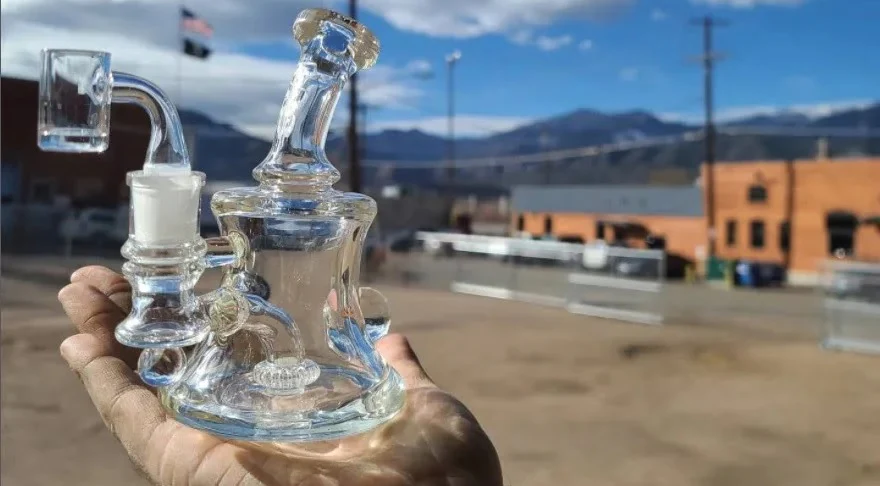You load the bowl, spark it, pull, and instead of that rich, earthy taste, you get something sharp, musty, maybe even metallic.
It’s frustrating. You paid for good flower. You cleaned your piece (at least you think you did).
And yet, every hit tastes like it came out of an old sock drawer. Why?
Bad bong taste isn’t random.
It results from overlooked buildup, poor airflow, junk materials, or subtle chemistry working against you. I’ve spent years refining glass that performs, and I can tell you that most issues are fixable.
You’re not crazy. You’re not alone. And no, you don’t need to throw out your stash or your setup.
The #1 Reason Your Bong Tastes Bad: It’s Not As Clean As You Think
Let’s get one thing straight, what most people call “clean” doesn’t cut it.
A rinse here, a shake there, and suddenly the bong looks better. But glass doesn’t lie.
If the flavor is off, it’s because something is still lurking inside. In most cases, bad taste has nothing to do with the weed, and everything to do with what’s built up, stuck, soaked in, or left behind.
The problem is dirt, invisible grime, missed corners, and a misunderstanding of what “clean” really means. Here's where it hides.
Even “Clean” Bongs Can Be Dirty
You can’t always see the problem, but you’ll taste it.
Resin clings to narrow paths, especially in percolators, downstems, and the joint where the slide connects. Those spots never get enough attention, and they’re where flavor goes to die. Just a light haze of old oil is enough to taint a fresh bowl.
Your mouthpiece tells its own story.
Over time, lip oils, skin bacteria, and condensed vapor leave behind a greasy film, biofilm, to be exact. You won’t notice it visually, but it will coat your lips after a hit, and it’ll mess with the aftertaste.
And then there’s the water.
Leave it overnight? Welcome to the world of microscopic bacteria and early-stage mold. That slightly swampy taste? That’s not in your head.
Cleaning Mistakes That Leave a Bad Taste
Rinsing with warm water alone doesn’t remove resin. It just dilutes it and spreads it around.
If you’re not using high-concentration isopropyl alcohol (91% or better) with coarse salt, you’re not cleaning, you’re softening.
Next mistake? Letting it air dry without a full wipe or dry cycle.
That moisture becomes a breeding ground for mildew. Especially inside thin tubes or closed chambers where airflow is minimal.
And far too often, people forget the most abused components: the bowl and the slide.
These parts are closest to the flame, coated in combustion residue, and usually get the dirtiest the fastest. Neglect them, and you’ll keep getting that foul-tasting hit, even if the rest of the bong looks spotless.
New Bong? You Still Need to Clean It
Fresh from the box doesn’t mean flavor-ready.
Most new pieces carry trace amounts of polishing compounds, machine oil, or dust from the workshop. You might not smell it, but your lungs will notice. First session in a brand-new bong should never be dry-run.
Someone once asked, “I cleaned it three times with different methods, why does it still taste like resin?”
The truth? You probably missed the spots that matter most, or relied on cleaning products that left behind something worse.
Let’s Talk Materials and Taste
Bad taste doesn’t just come from what’s inside your bong, it can come from the bong itself.
The material you’re smoking through plays a bigger role than most people realize. And if you’ve ever wondered why your weed tastes amazing in a joint but like burnt plastic in your rig, the answer may be sitting right in front of you, literally.
Glass, Silicone, Acrylic, Which Affects Taste Most?
Glass is still the gold standard, and for good reason. All of our best bongs including the easy-to-clean 18’’ Straight Tube model are made exclusively out of borosilicate glass.
It’s flavor-neutral, heat-resistant, and easy to clean, when it’s thick and high-quality. But thin-walled glass is another story. It scratches easily, absorbs heat unevenly, and can trap resin deep in micro-fractures.
Over time, that residue changes the way your weed tastes, even if you clean the surface.
Silicone has flexibility going for it, but it’s a sponge when it comes to flavor. Terpenes cling to its surface, and even after a deep clean, ghost flavors from past sessions can linger.
What’s worse.
Silicone can absorb odor permanently, muting the flavor of fresh herb no matter how good the bud is.
Acrylic? Forget it. It’s cheap, sure, but that low price comes at the cost of flavor. When warm, acrylic can emit a plastic smell that seeps into the smoke. Some users report that it never truly goes away.
Helpful Resource -> Silicone Vs. Glass Bongs
Is Your Bowl or Downstem to Blame?
Airflow matters. A poorly designed downstem chokes your pull, turning smooth smoke into muddy vapor.
Cheap slides and single-hole bowls clog fast, roast unevenly, and concentrate residue in one place. And if the bowl is coated in old resin? You’re just relighting the past.
Also, watch out for cheap metal or plastic components, they don’t handle heat well. They warp, crack, and sometimes off-gas, especially if you torch your bowls.
Quality matters here, too.
A good downstem with proper diffusion slits and a multi-hole bowl is an upgrade that can help reclaim flavor.
How Smoke Behavior Changes Flavor in Your Bong
Even with a clean piece and solid flower, you can ruin a hit just by waiting too long, or using the wrong water. Smoke isn’t static. It breaks down quickly, and the moment it lingers in the chamber, it starts losing everything you actually want to taste.
There’s a science to how your bong interacts with smoke, and if you don’t respect it, the flavor pays the price.
Stale Smoke Is Real (And It Tastes Terrible)
Smoke begins degrading almost immediately.
Within three seconds of hanging around in your bong, it starts to oxidize. That means the lighter aromatic compounds, your terpenes, evaporate or cling to the glass, while what’s left behind thickens into bitter, stale gas.
That hit you took after your friend didn’t clear the chamber?
That wasn’t just old smoke, it was chemically altered, and not in a good way. It tasted like it had been sitting in a burnt popcorn bag because, functionally, that’s what happened.
“Why does it taste worse if I wait a few seconds before inhaling?”
Because the longer smoke sits, the more it coagulates. What was once a terp-rich cloud becomes a harsh, lifeless drag.
Smoke + Water = Weird Chemistry
Water’s great for cooling, but it changes the equation.
As smoke bubbles through it, water pulls out some of the oils, ash, and volatile organic compounds (VOCs). That’s the filtration you want.
But once the water gets used up, it starts feeding those same compounds back into the hit.
In some setups, you’ll even notice an oily, cloudy residue in the base, almost like engine coolant. That’s tar and emulsified smoke oils breaking down.
“Can my water type actually affect flavor?”
Yes, 100%. Hard tap water carries minerals that clash with smoke compounds. Filtered or distilled water keeps the taste closer to the source, your flower, and avoids the funky aftertones of municipal plumbing.
Your Lighter, Flame, and Technique Affect the Taste
A lot of people obsess over the bong, the water, the glass, but then light their bowl with a torch flame like they’re trying to weld a pipe.
The truth is, your lighter and how you use it play a massive role in how your weed tastes.
You can have perfect airflow, pristine glass, and top-shelf flower, but if you scorch the bowl or overpack it, you’re setting yourself up for disappointment.
Lighter Choice = Flavor Choice
Jet torches are great for dabs, but for flower? Total overkill. They burn hot, fast, and indiscriminately.
You’re not lighting a cigar, you're trying to unlock flavor, not incinerate it.
Standard butane lighters are better, but even they introduce combustion byproducts, exhaust, mostly, that can change the taste of your hit.
If you’ve ever caught a faint taste of fuel in the back of your throat, that’s why.
Want cleaner flavor? Use hemp wick. It lights cooler, doesn’t add off-gassing, and gives you more control. Once you switch, you’ll notice how much more of your bud’s terpene profile actually comes through.
Bowl Packing and Burn Style
Packing technique matters. Overpacked bowls smother combustion. You’ll get a crusty outer ring, an undercooked middle, and an inconsistent burn that tastes more like ash than herb.
“Cornering” the bowl, that is, lighting only a small edge rather than roasting the full top, preserves flavor and stretches your green further.
A gentle, controlled light is the difference between a smooth, tasty hit and a bitter lungful of regret.
“Is my weed bad or is my gear just trash?”
If your joints taste better than your bong hits, it’s not your bud, it’s everything else. From flame to draw to airflow, flavor loss often starts at the very moment you light up. And if nothing tastes right? Yeah, time to revisit your stash. Even the best setup can’t fix bad flower.
Engineering and Airflow: Why Premium Bongs Taste Better
Clean glass isn’t the only part of great flavor. Engineering and airflow is the purveyor the path your smoke takes.
Airflow design is one of the most overlooked elements in bong construction, yet it’s one of the biggest contributors to taste.
If your piece feels like a workout to pull from, or if it tastes muddled no matter how clean everything is, your airflow could be the real culprit.
Airflow Design Directly Impacts Flavor
When airflow isn’t engineered properly, smoke doesn’t flow, it crashes.
Turbulent pathways create drag, slow the hit down, and cause smoke to stagnate inside the chamber. What should be a smooth draw becomes a chore, and by the time the smoke hits your lips, it’s stale.
Percolators are often blamed for bad taste, but it’s not about having percs, it’s about the right ones.
Overcomplicated tree percs that clog easily are flavor killers, especially when they go uncleaned. On the flip side, precision-cut honeycomb percs and super slit downstems maximize filtration without choking airflow.
The Case for Better Accessories
A standard downstem is a bottleneck. A multi-slit downstem? That’s a flavor upgrade.
It disperses smoke evenly, cools efficiently, and delivers a smoother hit.
Pair that with a multi-hole slide for even combustion, and you eliminate the hotspots that lead to harshness.
Want to take it further? A quartz bowl offers unmatched heat resistance and preserves the original taste of your flower better than cheap glass or metal ever could.
Quick Fixes and Long-Term Solutions
You don’t need a full gear overhaul to start tasting the difference.
Some of the biggest improvements come from simple changes, things you can do today, without dropping a dime. That said, if you’re chasing consistent, clean flavor in every hit, there are upgrades worth making.
Here’s how to fix bad bong taste fast, and how to keep it from coming back.
Immediate Fixes You Can Try Today
Start by giving your bong a real clean.
ISO alcohol (91% or higher) and coarse salt are your best friends here. Shake, rinse with hot water, and don’t forget to dry every part fully, including joints, percs, and the mouthpiece.
Next, ditch the tap water. Cold, filtered water smooths the hit and helps preserve terpene flavor. If your local water tastes like chlorine, guess what your weed is going to taste like?
Finally, replace your lighter with hemp wick.
You’ll notice an instant difference. It burns cooler, doesn’t add butane fumes to your inhale, and gives you better control when lighting the bowl.
Long-Term Upgrades That Preserve Flavor
If you’re serious about your smoking experience, invest in quality glass. Thick borosilicate (9mm or more) doesn’t just last longer, it resists scratches and flavor-trapping microfractures.
Upgrade your downstem to a super-slit design for better airflow and cooler hits. Combine that with a multi-hole slide or quartz bowl, and you’ll eliminate harsh combustion hotspots.
Want to stay cleaner longer? Add a glass ash catcher. It intercepts residue before it gets into the main chamber, keeping your bong tasting fresher for more sessions with less cleaning.
You Don’t Have to Tolerate Bad Bong Taste
If your bong tastes bad, it’s not just a fluke, it’s a signal.
A sign that something in your setup is holding you back from the flavor your flower deserves. Whether it’s resin buildup, airflow issues, or low-grade materials, there’s always a fix.
And the truth is, the difference between a harsh hit and a clean one isn’t magic, it’s engineering, quality, and attention to detail.
At Thick Ass Glass, we obsess over the details because we know they matter.
If you’re ready to stop guessing and start tasting, take a look at what we’ve designed for smokers who expect more at Thick Ass Glass.


